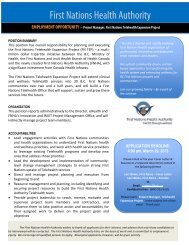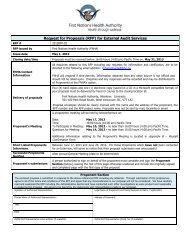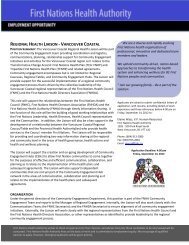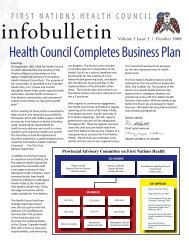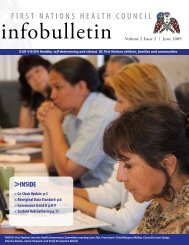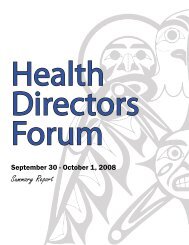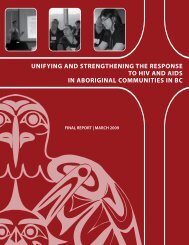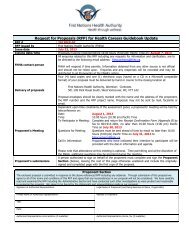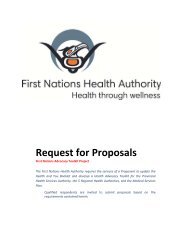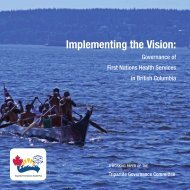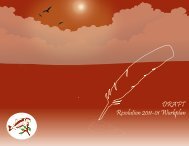pdf download - First Nations Health Council
pdf download - First Nations Health Council
pdf download - First Nations Health Council
Create successful ePaper yourself
Turn your PDF publications into a flip-book with our unique Google optimized e-Paper software.
HEALTH PROMOTION, DISEASE AND INJURY PREVENTION<br />
18<br />
Community-based health programs are<br />
being developed to assist <strong>First</strong> <strong>Nations</strong> to deal<br />
with health promotion and disease and injury<br />
prevention issues affecting their communities, so<br />
that the incidence of preventable diseases and<br />
injuries in the <strong>First</strong> <strong>Nations</strong> population becomes<br />
comparable to that of other British Columbians.<br />
Key to the strategy is: Increasing access to<br />
traditional foods and medicines, improving food<br />
security, and developing culturally appropriate<br />
health promotion and prevention tools.<br />
Holistic <strong>Health</strong> Programs<br />
Although the TFNHP does not have an action<br />
item entitled ‘Holistic <strong>Health</strong>’ it is clear from<br />
the various actions and strategies contained<br />
within it that the <strong>First</strong> <strong>Nations</strong> priority for holistic<br />
approaches is an underlying principle. This<br />
discussion table was convened in order to provide<br />
guidance to how holistic approaches could be more<br />
effectively intertwined with the activities within<br />
the TFNHP.<br />
Question 1: What does holistic health mean to<br />
you?<br />
• Depends on individual, family and community.<br />
• Holistic – integration of all elements of health.<br />
Question 2: What does a holistic health program<br />
look like?<br />
• Include traditional approaches.<br />
• Support ability of Aboriginal frontline staff to<br />
take this message into the homes.<br />
• Provide training on traditional practices.<br />
Question 3: How would we pursue a holistic<br />
health program within the tripartite process?<br />
• Advocate for holistic approaches within<br />
tripartite processes.<br />
ActNow: General<br />
As described in the TFNHP and the <strong>First</strong> <strong>Nations</strong><br />
<strong>Health</strong> <strong>Council</strong>’s “Year in Review 2007-2008”<br />
participation in ActNow BC was initiated through<br />
the University of Northern British Columbia,<br />
and is being implemented through <strong>First</strong> <strong>Nations</strong><br />
ActNow specific projects (e.g. Community Tool<br />
Kits), collaborations with other health initiatives<br />
(e.g. Aboriginal Diabetes Initiative, <strong>First</strong> <strong>Nations</strong><br />
Education Steering Committee), and partnerships<br />
with other ActNow BC programs (e.g. Action<br />
Schools BC) to expand <strong>First</strong> <strong>Nations</strong> access to<br />
as many ActNow BC programs as possible. In<br />
commenting on how the ActNow Initiative could<br />
respond to <strong>Health</strong> Promotion and Chronic Disease<br />
prevention issues the participants noted that:<br />
• Community role models/mentors need to be<br />
recognized.<br />
• Community dialogues should take place in<br />
order to identify strategies and plans.<br />
• There needs to be more training on <strong>Health</strong><br />
Promotion for community health workers –<br />
needs to be access to <strong>Health</strong> Promotion tools.<br />
• Leadership needs to put Chronic Disease<br />
Prevention and <strong>Health</strong> Promotion on their<br />
agendas.<br />
• Leadership needs to live healthy lives since they<br />
are role models.<br />
• mental health should be included in the Action<br />
<strong>Health</strong> Promotion strategy.<br />
• Provincial <strong>First</strong> Nation Centre of Excellence<br />
for Chronic Disease Prevention should be<br />
established.<br />
• Research, literature, and health promotion<br />
resources need to be developed at the<br />
community to community level.<br />
• Funding needs to be larger and sustainable for<br />
<strong>Health</strong> Promotion strategies.<br />
ActNow: Physical Activity<br />
Within the four pillars of ActNow (i.e. Tobacco<br />
Cessation, <strong>Health</strong>y Choices in Pregnancy,<br />
Nutrition, and Physical Activity) <strong>First</strong> <strong>Nations</strong> have<br />
emphasized Physical Activity and Nutrition as<br />
priorities for action that have the most potential<br />
for improving health outcomes and impacting<br />
on the other pillars of ActNow. During the 2007<br />
Gathering Wisdom forum the physical activity and<br />
nutrition elements were addressed at one table.<br />
For this 2008 Gathering separate table discussions<br />
were convened. In summary the participants<br />
encouraged:<br />
• Validate and include physical activity as an<br />
essential cornerstone to improve health by<br />
including it in the Accord.<br />
• Provide more youth activities that are longterm<br />
not just project based (e.g. Boys Clubs).<br />
Also need Girls Clubs for adolescent girls that<br />
are driven by young women rolemodels. These<br />
clubs can build self-esteem, leaders in training,<br />
activities, etc.<br />
• Community has individual needs and resources<br />
– develop strategic plans suited for community<br />
and to assist in making physical activity a<br />
priority (i.e., needs assessments to know<br />
challenges, weather, respond to community<br />
feedback, generate community support, etc.)<br />
• Ideas to reduce barriers included consideration<br />
of a universal BC passcard to help you go to<br />
II<br />
SECONd ANNUAl FORUm



